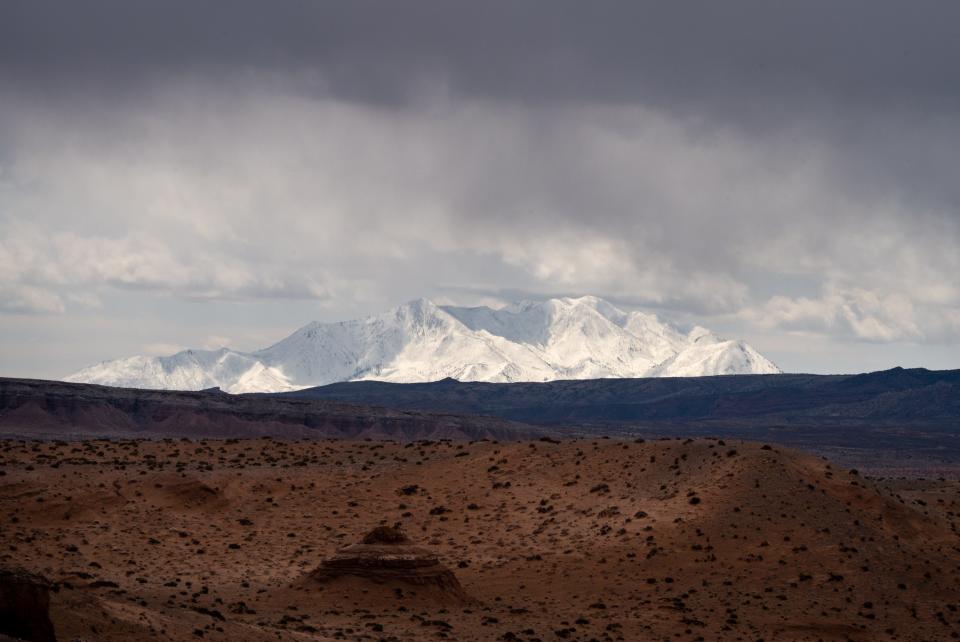Snowy, wet winter brings drought reprieve, but it won't solve Colorado River water woes
Snowy and cool conditions that persisted across the West through last month will likely create a gush of water unlike any the Colorado River has seen since 2011, river forecasters say.
The expected snowmelt should protect hydroelectric power production at Glen Canyon Dam and prevent immediate losses to already depleted reservoirs serving the Southwest, regional and federal officials say.
But it won’t break a 23-year megadrought’s threat to water supplies in coming years.
“Even with this winter’s weather, conservation is more important now than ever,” Arizona Gov. Katie Hobbs said during a Thursday news conference celebrating federal funding for water savings by the Gila River Indian Community.
Lake Powell, the giant holding tank straddling Arizona’s northern boundary, is currently forecast to receive 11.3 million acre-feet of water during the April-July snowmelt runoff season, the National Weather Service’s Colorado Basin River Forecasting Center said Friday. That’s 177% of what it has averaged over a 30-year period marked by extreme lows linked to a warming climate.
If the river flows as expected, it will nearly double the volumes in two of the last three years, and nearly triple the volume recorded in 2021. Still, in a river with the nation's two largest reservoirs sitting at roughly three-quarters empty, one good year doesn't end drought. Refilling Lake Powell alone would take two years like this one even if none of the millions of downstream residents or farmers demanded any water from it.
Water storage: 'Weather chaos' brings enough snow to fill Verde River reservoirs, ease drought conditions
States can't let up on conservation measures
The rush of cold water past Moab, Utah, in late March had Josh Stoner stoked for what’s to come.
“A ton of snow!” the Grand Junction, Colorado, resident said after emerging in a dry suit from a riffle at the river’s Big Bend Beach. “Super excited!”
Stoner and friends were in Utah for a swift-water rescue course in preparation for a rafting trip later this summer. They joined a dozen or so people floating through the riffle and taking turns getting reeled in with floating ropes. He is an experienced rafter who expects big things from the river this year. Flows in western Colorado have peaked early, in May, during the last several years, he said. This year he expects the big fun to last into June.
Arizona’s top water official, Tom Buschatzke, was decidedly less exuberant on Thursday. As director of the state Department of Water Resources, he remains immersed in talks to persuade water users within Arizona and beyond to share further reductions to ensure a reliable source next year and for years to come.
“We’re still working on a deficit,” he said. “We have to keep the pedal to the metal.”
If the flows materialize as expected, he said, it means Glen Canyon Dam won’t stop producing power this year, and likely not next year either. If the next two years are poor — similar to a dry year like, say, 2002 — the dam’s power plant could again be threatened, he said.
The river forecasting center does not compile total flow projections for tributaries downstream of Lake Powell, but its current snowpack estimates along the Little Colorado and Virgin rivers show potential far above a normal year. In all, it should spell a year in which severely depleted reservoirs slow or stop their recent plunges.
Lake Powell, now holding just 5.3 million acre-feet, is at 23% of capacity, while farther downstream, Lake Mead is at 28% with 7.4 million. The government measures water by the acre-foot, or amount needed to cover an acre to 1-foot deep, roughly 326,000 gallons.
Lake Mead: Feds finalizing $250M in water-saving measures to help drought-stricken Lake Mead
The same "atmospheric rivers" helping the Colorado have dumped colossal snows and rains elsewhere in the drought-stricken West, helping top off reservoirs in central Arizona and California. San Luis Reservoir, California's fifth-largest, has refilled after sitting at one-quarter full in December. But that reservoir is just a tenth the size of Lake Powell.
Last month, before continued snowfall improved the outlook, the dam-managing U.S. Bureau of Reclamation projected Powell’s surface elevation would end this year somewhat higher than it began. Lake Mead would continue to decline, by about 8 feet, but with more water perched upstream in Powell for later release. Though these are relatively minor changes, it’s unclear how they might affect mandated reductions among farmers and other water users.
The Bureau of Reclamation is set to release proposed emergency conservation measures next week, accounting for two decades of declines.
Dividing water: As Colorado River is stretched thin by drought, can 100-year-old rules that divide it still work?
'We've never had two good winters in a row'
Recent disappointing years were marred by dry and warm springs that sponged up much of what otherwise could have been decent flows based on snowpack alone. Utah’s dry soils could again steal significant snowmelt this year, river forecaster Cody Moser said, but that state’s mountains also have the amplest snowpack now and were factored into the forecasting model. Soils in Arizona and western Colorado are relatively wetter thanks to summer and fall rains.

“We’ve had a couple pretty good monsoon seasons,” Moser said.
While pleased with the predictions, Central Arizona Water Conservation District board member Terry Goddard said it’s premature to celebrate. His district, which manages the Central Arizona Project Canal delivering water from the river, has already been hit hard by water reductions forced by Lake Mead’s slide. He considers this year’s heavy snows a “short reprieve” from nearly a quarter-century of spiraling disaster.
During that time, he cautioned, “We’ve never had two good winters in a row.” And it would take more than two to refill the reservoirs to comfortable levels.
Like Buschatzke, Goddard said it’s imperative that all seven states negotiating their commitments to save water retain their urgency. Otherwise, he said, next year’s snowpack could deliver calamity.
Snowmelt: Salt River Project opens Bartlett Dam floodgates to make room for spring snowmelt
“We’re hoping that we continue the momentum” built over the last several dry years, Goddard said.
What happens next is in the federal government’s hands. After proclaiming last year that the seven states needed to conserve between 2 million and 4 million acre-feet a year to stabilize the reservoirs, the U.S. Interior Department asked the states to work out an agreement on how to do it. So far the states have not agreed on how to split up those cutbacks, and next week the department will reveal its own plan.
Deputy Interior Secretary Tommy Beaudreau traveled to Phoenix to tout the Biden administration’s commitment to conservation during Thursday’s news conference at the governor’s office. While there, he assured Arizonans that the administration will use “every tool” to save the river and, with it, the region’s economy.

“This is one of the most significant challenges facing the United States today,” Beaudreau said.
Brandon Loomis covers environmental and climate issues for The Arizona Republic and azcentral.com. Reach him at brandon.loomis@arizonarepublic.com or follow on Twitter @brandonloomis.
Environmental coverage on azcentral.com and in The Arizona Republic is supported by a grant from the Nina Mason Pulliam Charitable Trust. Follow The Republic environmental reporting team at environment.azcentral.com and @azcenvironment on Facebook, Twitter and Instagram.
Support local journalism. Subscribe to azcentral.com today.
This article originally appeared on Arizona Republic: Forecasters say Colorado River due for best flows in 12 years

